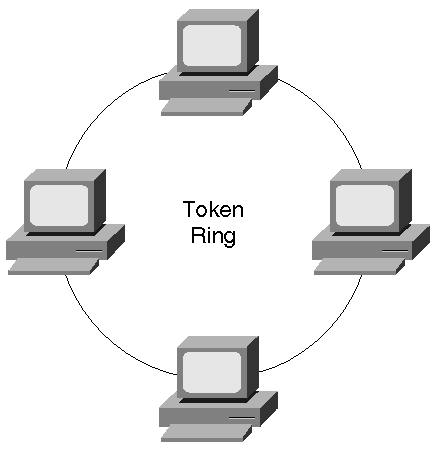Token Ring
This chapter began with an overview of LAN access methods. To this point, you should be familiar with the various options using the CSMA/CD method. This section briefly examines Token Ring, the other popular form of LAN access.
Token Ring systems, like Ethernet, use a shared media technology. Multiple stations attach to a network and share the bandwidth. Token Ring supports two bandwidth options: 4 Mbps and 16 Mbps. The 4 Mbps version represents the original technology released by IBM. 16 Mbps, a version released after 4 Mbps, essentially works the same as 4 Mbps Token Ring and introduces a couple of optional new features to further improve the system.
Token Ring Operations
To control access onto the system, Token Ring passes a token on the network that authorizes the current holder to transmit onto the cable. Figure 1-12 illustrates a logical representation of a Token Ring system.
Figure 1-12. A Simple Token Ring Network

Each station in the network creates a break in the ring. A token passes around the ring from station to station. If a station desires to send information, it holds onto the token and starts to transmit onto the cable. Assume Station 1 wants to transmit to Station 3. Station 1, when it receives a token, possesses the token and transmits the frame with Station 3's MAC address as the destination and Station 1's MAC address as the source. The frame circulates around the ring from station to station. Each station locally copies the frame and passes it to the next station. Each station compares the destination MAC address against its own hardware address and either discards the frame if they don't match, or sends the frame to the processor. When Station 2 receives the frame, it too copies the frame and sends it on to the next station. All stations receive a copy of the frame because, just like Ethernet, Token Ring is a broadcast network. The frame eventually returns to the source. The source is responsible for removing the frame and introducing a new token onto the network.
In this model, only one station at a time transmits because only one station can possess the token at a time. Some network inefficiencies result, however, when a station retains the token until it removes the frame it transmitted from the ring. Depending upon the length of the ring, a station can complete transmission of a frame before the frame returns back to the source. During the time between the completion of transmission and the removal of the frame, the network remains idle no other station can transmit. This amounts to wasted bandwidth on the network. Early token release, an optional feature introduced with 16 Mbps Token Ring, permits the source to create a new token after it completes transmission, and before it removes its frame from the network. This increases the Token Ring utilization to a much higher degree than for systems without early token release.
Occasionally, a source might not be online whenever the frame it transmitted returns to it. This prevents the source from removing the frame and causes it to circulate around the network possibly indefinitely. This consumes bandwidth on the network and prevents other stations from generating traffic. To prevent this, one of the stations on the ring is elected to be the ring monitor. Whenever a packet circulates around the ring, the ring monitor marks a particular bit in the frame indicating, "I already saw this frame once." If the ring monitor sees any frame with this bit set, the ring monitor assumes that the source cannot remove the frame and removes it.
Token Ring Components
Token Ring systems use a hub architecture to interconnect stations. The hub, called a multistation access unit (MAU), creates a logical ring from the star attached stations as shown in Figure 1-13.
Figure 1-13. Token Ring Stations Attached to an MAU

Internal to the MAU, the transmit from one station connects to the receive of another station. This continues between all attached stations until the ring is completed. What happens if a user detaches a station? When this occurs, the MAU bypasses the unused port to maintain ring integrity.
A network administrator can daisy-chain MAUs together to extend the distance and to introduce more ports in the network. Figure 1-14 illustrates how MAUs usually have ring-in (RI) and ring-out (RO) ports to attach to other MAUs.
Figure 1-14. Cascading Token Ring MAUs

EAN: N/A
Pages: 223